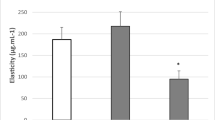ABSTRACT
Resveratrol-phospholipid complex (Phytosome®) (RSVP) was found better aqueous soluble and permeable than free resveratrol (RSV). RSVPs were incorporated in polymeric patch prepared by solvent casting method using Eudragit RL 100, PVP K30, and PEG 400 for application on dermal sites for sustained treating of inflammation. Prepared patches were evaluated for various physicochemical properties, surface morphology by SEM, TEM, and compatibility of patch components by FT-IR and DSC studies. Optimized formulation (F9) gave 95.79 ± 3.02% drug release and 51.36% (4.28 ± 0.48 mg/cm2) skin permeation after 24 h. Skin extract when examined for drug accumulation showed 38.31 ± 2.42% drug content. FE-SEM images of the patch taken after drug release and skin permeation studies showed that RSVPs in polymeric patch are stable and retain their structure after 24 h long exposure to physiologic environment. Sustained anti-inflammatory effect was established in carrageenan-induced paw edema model in which test formulation gave 84.10% inhibition of inflammation at 24 h as compared to 39.58% for standard diclofenac sodium gel. The CLSM study confirmed the localization of RSVPs for a longer period, thus enabling drug targeting to the dermis for sustained effect. Skin irritation test on rabbit revealed that the patches are safe for skin application. Histological observations suggested that after exposure to the permeants, the SC integrity had not altered and no evidence of presence of inflammatory cells found. RSVP (Phytosome®) containing patches abled to give sustained therapeutic effect that may be useful in treating acute and chronic inflammation.











Similar content being viewed by others
REFERENCES
Frémont L. Biological effect of resveratrol. Life Sci. 2010;66:663–73.
Paul B, Masih I, Deopujari J, Charpentier C. Occurrence of resveratrol and pterostilbene in age-old darakchasava, an ayurvedic medicine from India. J Ethnopharmacol. 1999;68(1–3):71–6.
Arichi H, Kimura Y, Okuda H, Baba K, Kozawa M, Arichi S. Effects of stilbene components of the roots of Polygonum cuspidatum Sieb. et Zucc. on lipid metabolism. ChemPharm Bull (Tokyo). 1982;30:1766–70.
Frankel EN, Waterhouse AL, Kinsella JE. Inhibition of human LDL oxidation by resveratrol. Lancet. 1993;341:1103–4.
Khanduja KL, Bhardwaj A, Kaushik G. Resveratrol inhibits N-nitrosodiethylamine-induced ornithine decarboxylase and cyclooxygenase in mice. J Nutr Sci Vitaminol (Tokyo). 2004;50:61–5.
Narayanan BA, Narayanan NK, Stoner GD, Bullock BP. Interactive gene expression pattern in prostate cancer cells exposed to phenolic antioxidants. Life Sci. 2002;70:1821–39.
Hung LM, Su MJ, Chen JK. Resveratrol protects myocardial ischemia-reperfusion injury through both no-dependent and no-independent mechanisms. Free Radic Biol Med. 2004;36:774–81.
Picard F, Kurtev M, Chung N, Topark-Ngarm A, Senawong T, Oliveira RM, et al. Sirt1 promotes fat mobilization in white adipocytes by repressing PPAR-gamma. Nature. 2004;429:771–6.
Tsunoda I, Rose JW, Rojas M, Hasanovic F, Carlson NG. Treatment of an animal model for multiple sclerosis with resveratrol, a natural compound in red wine. J Neuroimmunol. 2008;203(2):247.
Norata GD, Marchesi P, Passamonti S, Pirillo A, Violi F, Catapano AL. Anti-inflammatory and anti-atherogenic effects of cathechin, caffeic acid and trans-resveratrol in apolipoprotein E deficient mice. Atherosclerosis. 2007;191:265–71.
Bourgeois S, Tsapis N, Honnas H, Andremont A, Shakweh M, Besnard M, et al. Colonic delivery of beta-lactamases does not affect amoxicillin pharmacokinetics in rats. J Pharm Sci. 2008;97(5):1853–63.
Subbaramaiah K, Chung WJ, Michaluart P, Telang N, Tanabe T, Inoue H, et al. Resveratrol inhibits cyclooxygenase-2 transcription and activity in phorbol ester-treated human mammary epithelial cells. J Biol Chem. 1998;273(34):21875–82.
Catalgol B, Batirel S, Taga Y, Ozer NK. Resveratrol: French paradox revisited. Front Pharmacol. 2012;3:141. doi:10.3389/fphar.2012.00141.
Chen G, Shan W, Wu Y, Ren L, Dong J, Ji Z. Synthesis and anti-inflammatory activity of resveratrol analogs. Chem Pharm Bull (Tokyo). 2005;53:1587–90.
Birrell MA, Mccluskie K, Wong S, Donnelly LE, Barnes PJ, Belvisi MG. Resveratrol, an extract of red wine, inhibits lipopolysaccharide induced airway neutrophilia and inflammatory mediators through an NF-Kappa B-independent mechanism. FASEB J. 2005;19:840–1.
Elmali N, Esenkaya I, Harma A, Ertem K, Turkoz Y, Mizrak B. Effect of resveratrol in experimental osteoarthritis in rabbits. Inflamm Res. 2005;54:158–62.
Wu SL, Yu L, Meng KW, Ma ZH, Pan CE. Resveratrol prolongs allograft survival after liver transplantation in rats. World J Gastroenterol. 2005;11:4745–9.
Rahman I. Dietary polyphenols mediated regulation of oxidative stress and chromatin remodeling in inflammation. Nutr Rev. 2008;66(1):S42–5. doi:10.1111/j.1753-4887.2008.00067.x.
Gresele P, Cerletti C, Guglielmini G, Pignatelli P, de Gaetano G, Violi F. Effects of resveratrol and other wine polyphenols on vascular function: an update. J Nutr Biochem. 2011;22:201–11.
Hurst S, Loi CM, Brodfuehrer J, El-Kattan A. Impact of physiological, physicochemical and biopharmaceutical factors in absorption and metabolism mechanisms on the drug oral bioavailability of rats and humans. Expert Opin Drug Metab Toxicol. 2007;3:469–89.
Amri A, Chaumeil JC, Sfar S, Charrueau C. Administration of resveratrol: what formulation solutions to bioavailability limitations? J Control Release. 2012;158:182–93.
Santos AC, Veiga F, Ribeiro AJ. New delivery systems to improve the bioavailability of resveratrol. Expert Opin Drug Deliv. 2011;8:973–90.
Vian MA, Tomao V, Gallet S, Coulomb PO, Lacombe JM. Simple and rapid method for cis- and trans-resveratrol and piceid isomers determination in wine by high-performance liquid chromatography using Chromolith columns. J Chromatogr A. 2005;1085(2):224–9.
Amidon GL, Lennernäs H, Shah VP, Crison JR. A theoretical basis for a biopharmaceutic drug classification: the correlation of in vitro drug product dissolution and in vivo bioavailability. Pharm Res. 1995;12:413–20.
Walle T, Hsieh F, Delegge MH, Oatis Jr JE, Walle UK. High absorption but very low bioavailability of oral resveratrol in humans. Drug Metab Dispos. 2004;32(12):1377–82.
Baur JA, Sinclair DA. Therapeutic potential of resveratrol: the in vivo evidence. Nat Rev Drug Discov. 2006;5(6):493–506.
Brown VA, Patel KR, Viskaduraki M, Crowell JA, Perloff M, Booth TD, et al. Repeat dose study of the cancer chemopreventive agent resveratrol in healthy volunteers: safety, pharmacokinetics, and effect on the insulin-like growth factor axis. Cancer Res. 2010;70(22):9003–11. doi:10.1158/0008-5472.CAN-10-2364.
Bone K. Resveratrol: what is an effective clinical dose? Nat Ther. 2011;26(2):15–6.
Perloff M, Gescher AJ, Steward WP, Brenner DE, Faust GE, Patel KR, et al. Phase I dose escalation pharmacokinetic study in healthy volunteers of resveratrol, a potential cancer chemopreventive agent. Cancer Epidemiol Biomark Prev. 2007;16(6):1246–52. doi:10.1158/1055-9965.EPI-07-0022.
Gokce EH, Korkmaz E, Dellera E, Sandri G, Bonferoni MC, Ozer O. Resveratrol-loaded solid lipid nanoparticles versus nanostructured lipid carriers: evaluation of antioxidant potential for dermal applications. Int J Nanomedicine. 2012;7:1841–50. doi:10.2147/IJN.S29710.
Anzaghi P, Pifferi G, Stefli R. Resveratrol-phospholipids complexes, their preparation, and pharmaceutical and cosmetic composition containing same. U.S. Patent 0116386A1, June 17, 2004.
Pando D, Caddeo C, Manconi M, Fadda AM, Pazos C. Nanodesign of olein vesicles for the topical delivery of the antioxidant resveratrol. J Pharm Pharmacol. 2013;65(8):1158–67. doi:10.1111/jphp.12093.
Hung CF, Lin YK, Huang ZR, Fang JY. Delivery of resveratrol, a red wine polyphenol, from solutions and hydrogels via the skin. Biol Pharm Bull. 2008;31(5):955–62.
Polonini HC, Bastos Cde A, de Oliveira MA, da Silva CG, Collins CH, Brandão MA, et al. In vitro drug release and ex vivo percutaneous absorption of resveratrol cream using HPLC with zirconized silica stationary phase. J Chromatogr B. 2014;947:23–31.
Kalita B, Das MK. Resveratrol-phospholipid complex (phytosomes) with improved physicochemical properties favorable for drug delivery via skin. World J Pharm Res. 2015;4(5):1497–517.
Mamatha T, Venkateswara RJ, Mukkanti K, Ramesh G. Development of matrix type transdermal patches of lercanidipine hydrochloride: physicochemical and in vitro characterization. DARU. 2010;18(1):9–16.
Amnuaikit C, Ikeuchi I, Ogawara K, Higaki K, Kimura T. Skin permeation of propranolol from polymeric film containing terpene enhancers for transdermal use. Int J Pharm. 2005;289:167–78.
Ramesh G, Vishnu YV, Kishan V, Madhusudan YR. Development of nitrendipine transdermal patches: in vitro and ex vivo characterization. Curr Drug Deliv. 2007;4:69–76.
Limpongsa E, Umprayn K. Preparation and evaluation of diltiazem hydrochloride diffusion-controlled transdermal delivery system. AAPS Pharm Sci Tech. 2008;9(2):464–70. doi:10.1208/s12249-008-9062-8.
Patel HJ, Patel JS, Desai BG, Patel KD. Design and evaluation of amlodipine besilate transdermal patches containing film former. Int J Pharm Res Dev. 2009;7:1–12.
Pathan IB, Setty CM. Comparison of the effect of essential oils on the permeation of Diclofenac Diethylamine through various barriers. Acta Pharm Sci. 2008;50:219–28.
Gupta R, Mukherjee B. Development and in vitro evaluation of diltiazem hydrochloride transdermal patches based on povidone–ethyl cellulose matrices. Drug Dev Ind Pharm. 2003;29(1):1–7.
Sankar V, Benito JD, Sivanand V, Ravichandran V, Raghuraman S, Velrajan G. Design and evaluation of nifedipine transdermal patches. Ind J Pharm Sci. 2003;65:510–5.
Kerimoglu O, Sahbaz S, Sehirli O, Dortunc B, Sener G. Mechanical evaluation of matrix type transdermal therapeutic systems containing captopril. Marmara Pharm J. 2015;19:67–72. doi:10.12991/mpj.2015198612.
Mehdzadeha A, Toliate T, Rouini MR, Abashzadeh S, Dorkooshm F. Design and in vitro evaluation of new drug-in-adhesive formulations of fentanyl transdermal patches. Acta Pharm. 2004;54:301–17.
Cilurzo F, Gennari CGM, Minghetti P. Adhesive properties: a critical issue in transdermal patch development. Expert Opin Drug Deliv. 2012;9(1):33–45. doi:10.1517/17425247.2012.637107.
Winter CA, Risley EA, Nuss GW. Carrageenan induced oedema in the hind paw of rat as an assay for anti-inflammatory activity. Proc Soc Exp Biol Med. 1962;111:544–7.
López-Pinto JM, González-Rodríguez ML, Rabasco AM. Effect of cholesterol and ethanol on dermal delivery from DPPC liposomes. Int J Pharm. 2005;298:1–12.
Draize JH, Woodword G, Calvery HO. Methods for the study of irritation and toxicity of substances applied topically to the skin and mucous membranes. J Pharmacol Exp Ther. 1944;82:377–9.
Kong M, Chen XG, Kweon DK, Park HJ. Investigations on skin permeation of hyaluronic acid based nanoemulsion as transdermal carrier. Carbohydr Polym. 2011;86:837–43.
Rajabalaya R, David SRN, Khanam J, Nanda A. Studies on the effect of plasticizer on in vitro release and ex vivo permeation from eudragit E 100 based chlorpheniramine maleate matrix type transdermal delivery system. J Excipients Food Chem. 2010;1(2):3–12.
Verma PRP, Murthy TEGK. Transdermal flubiprofen delivery using HPMC matrices: design, in vitro and in vivo evaluation. Drug Dev Ind Pharm. 1997;23:633–8.
Gantner DC, Schalau II GK, Thomas X. DOW CORNING: soft skin adhesive gels and liners: new formulating options for tailored solutions. Available at: http://www.dowcorning.com/content/publishedlit/52-1113.pdf. Accessed 25 Nov 2015.
Chen Y, Wu Q, Zhang Z, Yuan L, Liu X, Zhou L. Preparation of curcumin-loaded liposomes and evaluation of their skin permeation and pharmacodynamics. Molecules. 2012;17:5972–87. doi:10.3390/molecules17055972.
Bertacche V, Lorenzi N, Nava D, Pini E, Sinico C. Host–guest interaction study of resveratrol with natural and modified cyclodextrins. J Incl Phenom Macrocycl Chem. 2006;55:279–87.
Xu K, Liu B, Ma Y, Du J, Li G, Gao H, et al. Physicochemical properties and antioxidant activities of luteolin-phospholipid complex. Molecules. 2009;14(9):3486–93. doi:10.3390/molecules14093486.
Pereira GR, Collett JH, Garcia SB, Thomazini JA, Bentley MVLB. Glycerol monooleate/solvents systems for progesterone transdermal delivery: in vitro permeation and microscopic studies. Braz J Pharm Sci. 2002;38(1):55–62.
Rajesh K, Murugesan SK. Development of protransferrosomal system for effective transdermal delivery of nifedipine. World J Pharm Pharm Sci. 2014;3(9):604–23.
Naz Z, Ahmad FJ. Curcumin-loaded colloidal carrier system: formulation optimization, mechanistic insight, ex vivo and in vivo evaluation. Int J Nanomedicine. 2015;10:4293–307. doi:10.2147/IJN.S82788.
Meng S, Chen Z, Yang L, Zhang W, Liu D, Guo J, et al. Enhanced transdermal bioavailability of testosterone propionate via surfactant-modified ethosomes. Int J Nanomedicine. 2013;8:3051–60. doi:10.2147/IJN.S46748.
ACKNOWLEDGMENTS
The authors are thankful to SAIF, NEHU, Shillong (India), for allowing utilizing the SEM and TEM facility. We are thankful to IASST, Guwahati (India), for the access of FE-SEM facility. We are also thankful to the CIF of College of Veterinary Science, Guwahati. Further, the authors are thankful to the Guwahati Biotech Park, IIT Guwahati, for using the CLSM facility.
Author information
Authors and Affiliations
Corresponding author
Rights and permissions
About this article
Cite this article
Kalita, B., Das, M.K., Sarma, M. et al. Sustained Anti-inflammatory Effect of Resveratrol-Phospholipid Complex Embedded Polymeric Patch. AAPS PharmSciTech 18, 629–645 (2017). https://doi.org/10.1208/s12249-016-0542-y
Received:
Accepted:
Published:
Issue Date:
DOI: https://doi.org/10.1208/s12249-016-0542-y




